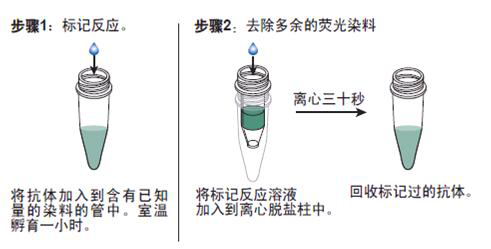
|

| 产地 | 进口、国产 |
| 品牌 | 上海莼试 |
| 保存条件 | Store at -20 °C |
| 货号 | CS11376 |
| 应用范围 | WB=1:100-500 ELISA=1:500-1000 IHC-P=1:100-500 IHC-F=1:100-500 Flow-Cyt=1:100-500 ICC=1:100-500 IF=1:100-500 |
| CAS编号 | |
| 抗体名 | Anti-SLITRK5 |
| 克隆性 | |
| 靶点 | 详见说明书 |
| 适应物种 | 详见说明书 |
| 形态 | 详见说明书 |
| 宿主 | 详见说明书 |
| 亚型 | IgG |
| 标识物 | 详见说明书 |
| 浓度 | 1mg/1ml% |
| 免疫原 | KLH conjugated synthetic peptide derived from human SLITRK5 |
产品订购信息:
英文名称 Anti-SLITRK5
中文名称 神经突触相关蛋白SLITRK5抗体说明书
别 名 bA364G4.2; KIAA0918; Leucine rich repeat containing 11; Leucine rich repeat containing protein 11; LRRC 11; LRRC11; SLIT and NTRK like family member 5; SLIT and NTRK like protein 5; Slit and trk like gene 5; SLITRK 5; SLIK5_HUMAN.


浓 度 1mg/1ml
规 格 0.2ml/200μg
抗体来源 Rabbit
克隆类型 polyclonal
交叉反应 Human, Mouse, Rat, Dog, Pig, Cow, Horse, Sheep
产品类型 一抗
研究领域 细胞生物 神经生物学 细胞膜蛋白
蛋白分子量 predicted molecular weight: 103kDa
性 状 Lyophilized or Liquid
免 疫 原 KLH conjugated synthetic peptide derived from human SLITRK5
亚 型 IgG
纯化方法 affinity purified by Protein A
储 存 液 Preservative: 15mM Sodium Azide, Constituents: 1% BSA, 0.01M PBS, pH 7.4
神经突触相关蛋白SLITRK5抗体说明书 产品应用 WB=1:100-500 ELISA=1:500-1000 IHC-P=1:100-500 IHC-F=1:100-500 Flow-Cyt=1:100-500 ICC=1:100-500 IF=1:100-500
(石蜡切片需做抗原修复)
not yet tested in other applications.
optimal dilutions/concentrations should be determined by the end user.
保存条件 Store at -20 °C for one year. Avoid repeated freeze/thaw cycles. The lyophilized antibody is stable at room temperature for at least one month and for greater than a year when kept at -20°C. When reconstituted in sterile pH 7.4 0.01M PBS or diluent of antibody the antibody is stable for at least two weeks at 2-4 °C.
Important Note This product as supplied is intended for research use only, not for use in human, therapeutic or diagnostic applications.
产品介绍 The leucine-rich (LRR) repeat is a 20-30 amino acid motif that forms a hydrophobic ?/∫ horseshoe fold, allowing it to accommodate several leucine residues within a tightly packed core. All LRR repeats contain a variable segment and a highly conserved segment, the latter of which accounts for 11 or 12 residues of the entire LRR motif. SLITRK5 (SLIT and NTRK-like family, member 5), also known as LRRC11 (leucine-rich repeat-containing protein 11), is a 958 amino acid single-pass type I membrane protein that contains 16 LRR repeats and belongs to the SLITRK family. Expressed at high levels in the cerebral cortex, but also present in areas of the spinal cord and medulla, SLITRK5 functions to suppress neurite outgrowth, thereby playing a regulatory role in neuronal function. The gene encoding SLITRK5 maps to human chromosome 13, which houses over 400 genes, such as BRCA2 and RB1, and comprises nearly 4% of the human genome. Trisomy 13, also known as Patau syndrome, is deadly and the few who survive past one year suffer from permanent neurologic defects, difficulty eating and vulnerability to serious respiratory infections.
Function : SLIT and NTRK-like family 5 (SLITRK5) is a member a protein family consisting of six homologous transmembrane proteins (SLITRK1-6) that share two conserved leucine-rich repeat domains in the extracellular domain and have significant homology to Slit, a secreted axonal growth-controlling protein. These proteins are also homologous to trk neurotrophin receptors in their intracellular domains. Expression of SLITRK proteins is highly restricted to neural and brain tumor tissues, but varies within the protein family. Like every other SLITRK protein except SLITRK1, overexpression of SLITRK5 inhibited neurite outgrowth in cultured neurons, suggesting that these proteins are involved in the control of neurite outgrowth.
Subcellular Location : Membrane; Single-pass type I membrane protein.
Tissue Specificity : Expressed predominantly in the cerebral cortex of the brain but also at low levels in the spinal cord and medulla.
Similarity : Belongs to the SLITRK family.
Contains 12 LRR (leucine-rich) repeats.
Contains 2 LRRCT domains.
Contains 1 LRRNT domain.
Database links : UniProtKB/Swiss-Prot: O94991.2

Anti-TNF- Alpha /Biotin 生物素标记 坏死因子抗体Multi-class antibodies规格: 0.2ml
Isulin (抗原)Multi-class antibodies规格: 0.5mg
兔抗大鼠sIgA抗体 Anti-Rat IgA 0.2ml
SDF4 英文名称: 基质细胞衍生因子4抗体(钙结合蛋白) 0.2ml
EFHC1 英文名称: EFHC1蛋白抗体 0.2ml
Rhesus antibody Rh phospho-MK3(Thr222) 磷酸化原活化蛋白激酶激酶3抗体 规格 0.1ml
Isulin (抗原)Multi-class antibodies规格: 0.5mg
Anti-OAT-1/FITC 荧光素标记阴离子转运蛋白-1(抗大、小鼠)抗体IgGMulti-class antibodies规格: 0.2ml
Rabbit Anti-bovine IgG/HRP 辣根过氧化物酶标记兔抗IgGMulti-class antibodies规格: 0.1ml
免疫球蛋白结合蛋白-1抗体 Anti-CD79A/IGBP-1 0.2ml
Goat Anti-Bovine IgG/Alexa Fluor 350 Alexa Fluor 350标记的羊抗IgG 0.1ml
FUT1 英文名称: 岩藻糖转移酶1抗体 0.2ml
Rhesus antibody Rh PLB/phospholamban 磷蛋白抗体 规格 0.1ml
Rabbit Anti-bovine IgG/HRP 辣根过氧化物酶标记兔抗IgGMulti-class antibodies规格: 0.1ml
PEG10(Paternally expressed gene 10) 高表达基因抗原Multi-class antibodies规格: 0.5mg
Anti-phospho-ATR/ACTR(Ser428) 磷酸化ATR抗体Multi-class antibodies规格: 0.1ml
Rhesus antibody Rh phospho-AMPK alpha-1(Ser485+Ser491) 磷酸化腺苷单磷酸活化蛋白激酶α1抗体 规格 0.1ml
p16INK4a 浓缩液 0.1ml 进口分装
USP1 英文名称: 泛素特异性蛋白酶1抗体 0.2ml
DNA Polymerase beta 英文名称: DNA聚合酶β抗体 0.2ml
Anti-phospho-ATR/ACTR(Ser428) 磷酸化ATR抗体Multi-class antibodies规格: 0.1ml
IL1A Protein Human 重组人 IL-1 alpha / IL1A / IL1F1 蛋白
小鼠甲状腺上皮细胞完全培养基 100mL
NRG1 Others Human 人 NRG1-alpha (ECD) 人细胞裂解液 (阳性对照)
Sf9昆虫卵巢细胞 Sf9 insect ovarian cells GPM-115无血清无蛋白昆虫细胞悬浮培养基(金普诺安 Cat#GPM001L01)
CL-0247ZR-75-1(人癌细胞)5×106cells/瓶×2
PC-3M-IE8(人高转移细胞株) 5×106cells/瓶×2 Lec1(卵巢细胞)
CM-R013大鼠肺大内皮细胞完全培养基100mL
UNC5B Others Rat 大鼠 UNC5B / UNC5H2 人细胞裂解液 (阳性对照)
人视网膜内皮细胞HREC
7F2细胞,小鼠杂交瘤细胞 人细胞,QBC939细胞 大鼠海马神经元RN-h
新生牛眼晶体上皮细胞;NBLE
MERTK Others Human 人 Mer / MERTK 人细胞裂解液 (阳性对照)
神经突触相关蛋白SLITRK5抗体说明书 IL1A Protein Human 重组人 IL-1 alpha / IL1A / IL1F1 蛋白
小鼠甲状腺上皮细胞完全培养基 100mL
NRG1 Others Human 人 NRG1-alpha (ECD) 人细胞裂解液 (阳性对照)
Sf9昆虫卵巢细胞 Sf9 insect ovarian cells GPM-115无血清无蛋白昆虫细胞悬浮培养基(金普诺安 Cat#GPM001L01)
CL-0247ZR-75-1(人癌细胞)5×106cells/瓶×2
PC-3M-IE8(人高转移细胞株) 5×106cells/瓶×2 Lec1(卵巢细胞)

抗体的生物素化标记实验要点:
1. 神经突触相关蛋白SLITRK5抗体说明书 如在反应混合液中有叠氮钠或游离氨基存在,会抑制标记反应。因此,蛋白质在反应前要对 0.1mol/L碳酸氢钠缓冲液或0.5mol/L硼酸缓冲液充分透析;
2.所用的NHSB及待生物素化蛋白质之间的分子比按蛋白质表面的ε-氨基的密度会有所不同,选择不当则影响标记的效率,应先用几个不同的分子比来筛选最适条件;
3.用NHSB量过量也是不利的,抗原的结合位点可能因此被封闭,导致抗体失活;
4.由于抗体的氨基不易接近可能造成生物素化不足,此时可加入去污剂如 Triton x-100, Tween20等;
5.当游离ε-氨基(赖氨酸残基的氨基)存在于抗体的抗原结合位点时,或位于酶的催化位点时,生物素化会降低或损伤抗体蛋白的结合力或活性;
6.生物素还可能与不同的功能基团,如羰基、氨基、巯基、异咪唑基及*基,也可与糖基共价结合;
7.交联反应后,应充分透析,否则,残余的生物素会对生物素化抗体与亲和素的结合产生竞争作用;
8.在细胞的荧光标记实验中,中和亲和素的本底低,但由于链霉亲和素含有少量正电荷,故对某些细胞可导致高本底。
抗体的鉴定:
1)神经突触相关蛋白SLITRK5抗体说明书 抗体的效价鉴定:不管是用于诊断还是用于,制备抗体的目的都是要求较高效价。不同的抗原制备的抗体,要求的效价不一。鉴定效价的方法很多,包括有试管凝集反应,琼脂扩散试验,酶联免疫吸附试验等。常用的抗原所制备的抗体一般都有约成的鉴定效价的方法,以资比较。如制备抗抗体的效价,一般就采用琼脂扩散试验来鉴定。
2)抗体的特异性鉴定:抗体的特异性是指与相应抗原或近似抗原物质的识别能力。抗体的特异性高,它的识别能力就强。衡量特异性通常以交叉反应率来表示。交叉反应率可用竞争抑制试验测定。以不同浓度抗原和近似抗原分别做竞争抑制曲线,计算各自的结合率,求出各自在IC50时的浓度,并按公式计算交叉反应率。
如果所用抗原浓度IC50浓度为pg/管,而一些近似抗原物质的IC50浓度几乎是无穷大时,表示这一抗血清与其他抗原物质的交叉反应率近似为0,即该血清的特异性较好。
3)抗体亲和力:是指抗体和抗原结合的牢固程度。亲和力的高低是由抗原分子的大小,抗体分子的结合位点与抗原决定簇之间立体构型的合适度决定的。有助于维持抗原抗体复合物稳定的分子间力有氢键,疏水键,侧链相反电荷基因的库仑力,范德华力和空间斥力。亲和力常以亲和常数K表示,K的单位是L/mol。抗体亲和力的测定对抗体的筛选,确定抗体的用途,验证抗体的均一性等均有重要意义。